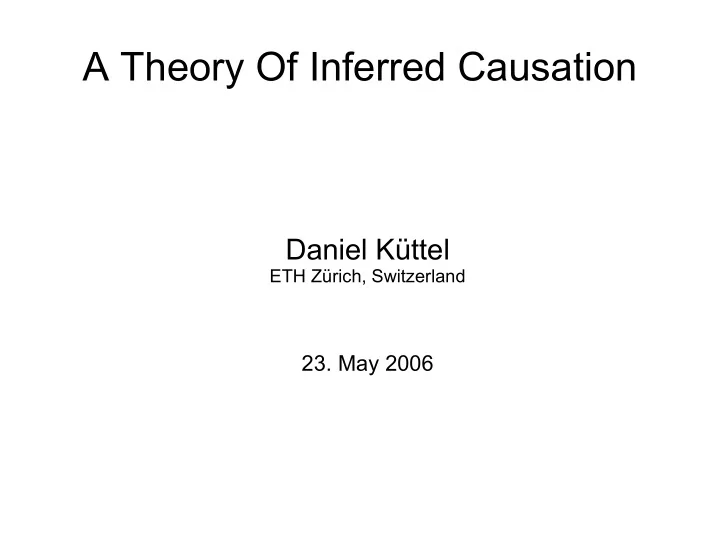

A Theory Of Inferred Causation Daniel Küttel ETH Zürich, Switzerland 23. May 2006
Our Task Find cause-effect relationships (causal model). Use only the information from uncontrolled observation of nature. (No controlled experiments!) empirical joint distribution over observable variables → causal model Should be possible because humans can do it.
Our Problems ● statistical dependence ≠ causality (← but not →) ● causal relationship vs spurious covariance ● hidden information/nodes (for example hidden common cause)
first thoughts ● Use temporal information, helps with: direction of causality common causes ● Identify statistical patterns and associate them with a causal interpration: no need for temporal information
Definitions 2.2.1 causal structure D = DAG, blueprint 2.3.2 latent structure <D,O> = D with Observables 2.2.2 causal model <D,Θ> = full model What now? Just find the causal model which can generate the observed joint distribution?
removing some ambiguity basic idea: Use the simplest working model that you can find. (The simpler the explanation the better.) less basic idea: The simpler the model the smaller its „expressive power“. L≤L': A latent structure L is simpler than L' if L' can mimic L (only looking at the observables).
the big thing Find (one) minimal L=<D,O> which is consistent: P O (L) = P empirical 2.3.6 inferred causation Given P empirical , C has a causal influence on E iff there is a directed path from C to E in every minimal L consistent with P empirical
yet another concept ... ... to remove ambiguity: stability Some independencies are structural and others are only „numerical“. Don't use models that allow „numerical“ indepencies (they are unstable).
recovering DAG structures inductive causation (IC) 1.For all a,b in V find S ab which renders a and b independent if conditioned on. Construct undirected graph with a,b connected if no such S ab exists. 2.For all a,b with common neighbor c: if c is in S ab , do nothing else, construct a → c ← b 3.In the resulting directed partially graph, orient as many edges as possible. Don't create new v-structures. Don't create directed cycles.
recovering latent structures Stability is no longer needed over O. Minimal latent structures don't have to be DAG structured. 2.6.1 Projection L [o] is a projection of L iff hidden variables are parentless common causes of two observables and L [o] and L have the same conditional indepencies
IC with latent variables (IC*) 1.Find S ab again and construct a-b if no S ab exists. 2.Construct a → c ← b again if possible. 3.Add arrows as long as the rules permit it.
local criteria for causal relations Certain statistical patterns allow us to infer causal relationships. There is always a third variable which allows us to do „an uncontrolled experiment“. („no causation without manipulation“)
local criteria for causal relations 2.7.1 Potential Cause: It's not the only cause. 2.7.2 Genuine Cause: Controlling X is controlling Y and X can screen Y from any further control. (+ closure) 2.7.3 Spurious Association: Leaves only a latent common cause as explanation.
using temporal information 2.7.4 Genuine Causation: Temporal precedence replaces potential cause. 2.7.5 Spurious Association: Only check for one direction of causality.
„inferred time“ / statistical time We expect causation to follow the timeline. Most techniques today didn't use temporal information. A correct DAG should hopefully give us a statistical time which coincides with the physical time. (May not always be the case.)
Recommend
More recommend